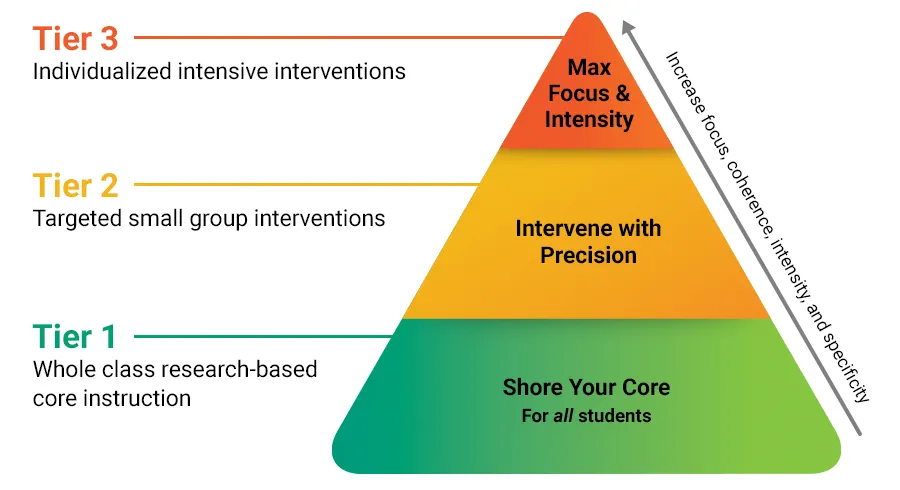Response to Intervention and Multi-Tiered Systems of Support
What Is RTI or MTSS?
RTI and MTSS are two popular, evidence-based approaches to intervention that use assessment data to inform instruction and provide support for students. Their purpose is to intervene early to provide the instructional support students need to thrive.
When it comes to intervention, there’s no one-size-fits-all solution. But at a baseline, any solution you choose should be able to help you accomplish all the following:
- Determine the level (or tier) of intervention students need
- Eliminate unnecessary steps in the screening process
- Provide targeted instruction and support for each student
- Monitor the success of your intervention strategies
What is the difference between RTI and MTSS?
RTI-based interventions typically target academic needs, whereas MTSS intervention strategies address academic and social, emotional, and behavioral programs, practices, and strategies. Many MTSS models include an RTI component.
Understanding RTI Tiers
RTI tiers indicate what level of intervention a student needs to be successful. They help teachers know where to increase the focus and intensity of instruction. We define RTI tiers of support as follows:
- Tier 1 Intervention: Scaffolded core instruction for all students delivered in whole class and small groups
- Tier 2 Intervention: Targeted, precise, small group instruction based on mutual needs
- Tier 3 Intervention: Intensive, focused support prioritizing the crucial off-grade level skills that students need to access grade-level instruction
An assessment tool can help teachers pinpoint—down to the domain level—exactly where each learner is and how to best support them.

Streamlining RTI/MTSS Intervention Screening
Universal screening is the first step in any evidence-based intervention program. Why? Because we need to know our students deeply. By screening all students a few times a year, schools can identify indicators of early risk factors and prevent the development of more significant difficulties down the road. Ideally, a screening assessment can provide data on multiple targeted skills so teachers get a profile of each student and their classroom from a single assessment. To reduce the need for multiple tests and to eliminate time-consuming steps in the instructional planning process, look for an assessment that uses student data to chart a personalized learning path.

Targeting Instruction: Next Steps You Can Feel Confident About
Once teachers identify students in need of intervention, they must determine what instruction to provide. Identifying the appropriate tools for effective small group and targeted intervention demands planning time and experience, so it’s critical for districts to support teachers with formative data, planning tools, and evidence-based resources. A good assessment tool can give teachers screening results that include priority domains for teaching, prerequisite skills, instructional groupings, and targeted supports for small group and individualized intervention.
Monitoring the Success of Your Intervention Strategies
Evaluating the success of intervention efforts requires robust and reliable progress monitoring. With well-designed assessments, progress monitoring allows teachers to understand where their students are and how far they need to go to get to grade-level proficiency. Ideally, a single assessment can be used for multiple purposes, including:
- Meeting reporting requirements
- Determining school intervention eligibility
- Identifying the best instructional resources and activities for students in need of support
See Our Intervention SolutionsWe can support your district’s systematic approach to intervention.
Related Resources
Alabama School District Reverses Trends and Brings More ...
In 2016, educators at Boaz City School (BCS) in Marshall County, Alabama were dismayed by the growing num...
Truly Responsive Teaching Means a New Approach to the RT...
Most educators are familiar with the green, yellow, and red triangle used to show the three tiers of inst...
Using Assessment Data to Supercharge Academic Interventi...
How to Use i-Ready Data to Improve a Multi-Tiered System of Supports (MTSS)
